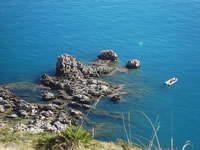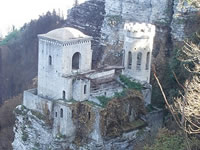Excursions in Scopello
 Castellammare del Golfo
Castellammare del GolfoCastellammare is the largest town of the area; its seashore reaches San Vito lo Capo and is considered one of the best coasts of the region. This little city was probably born back in the fifth century b.C., as the port of the near Segesta, and is nowadays visited by lots of tourists because of its beautiful landscape between mountains and beaches. The main points of interest are the castle, an extension of a former Arabic building realized by Normans and “Svevi”, and the “Chiesa Madre”, which guards the statue of “Madonna del Soccorso”, to whom the annual procession in August is dedicated.
 Zingaro nature reserve
Zingaro nature reserve
Zingaro nature reserve is a must-see in your holidays in Sicily, the heart of its western area: it is one of the very few parts of the Sicilian coast without a highway crossing it. People just wander around by feet through little paths designing itineraries among rocks, beaches, museums and vegetation, and from October to May it is possible to find rest in small buildings around the Sughero district for a one-night stay. This unspoilt environment lets the visitor spend a day of sun and beach or discover its nature and history through the museums: the Naturalistic Museum, the Seafaring Museum, the Rural society Museum and the Environmental Education Centre.
 Segesta
Segesta
On the Barbaro mountain, not far from Castellammare del Golfo, the small city of Segesta was probably already populated in the fourth century b.C. by Elimis – Greek refugees, running away from Troy. The hugest evidence of their transit is the Doric temple, the main point of interest in Segesta, built in the fifth century b.C. and probably never completed because of the never-ending wars against the near town of Selinunte. It is considered as one of the most beautiful temples in history, as it is still well-preserved and of good workmanship. On the opposite hill you will find the theatre, whose building probably dates back to the third century b.C.
 Erice
Erice
On the top of Erice mountain lies one of the most picturesque and peculiar hamlets of Sicily, founded by the same Elimis who built Segesta and named even by the great Virgilio in his epic poem “Eneide”. The village can be reached from the valley by car or bus, or by a cable car offering an astonishing overview of the Trapani area. The hamlet is protected by huge walls and is crossed by a lot of little streets – walking through them will make you feel like you were transported in a different age. The main points of interest are the castle with its breath-taking view of the valley and the “Chiesa Madre”; don't forget to taste “Genovesi alla crema”, typical butterfingered sweets filled with cream or ricotta.
Trapani
The provincial capital of the Scopello and Castellammare area is known as the “city of salt and sail”. The first people who probably occupied were the Elimis who had already built Segesta and Erice; whereas the legend states that the earth from which Trapani originates was created by the fall to the sea of the God Saturn's (city patron) sickle. Its territory is located in front of the point where Tirreno and Mediterranean sea meet – this makes the city very windy, and therefore suitable for a lot of important sailing competitions. Besides the several churches, museums and monuments, salt mines (“saline”) are a must-see: Trapani has been well-known for a long time for its salt production, and these still-working structures are an important evidence of archaeological architecture. Salt mines are included in “Trapani and Paceco Salt mines nature reserve”, with interesting samples of flora and fauna, which is run by WWF. Do not forget to get in touch with the typical cuisine: trapanese pesto can be tasted with pasta or slices of bread.
 Palermo
Palermo
Sicily's capital is a multi-ethnic, lively and ancient city. Its foundation, by Phoenicians, dates back to 734 b.c., and its history will be full of dominations: Romans, barbarians, Byzantines, Normans, Spanish etc. Evidences of these dominations are in every corner of the city, and their intertwining generates a very peculiar Mediterranean hybrid. There are really a lot of interesting places to see, from religious architecture (the Cathedral, Monreale dome, San Domenico, San Francesco, Santa Maria dello Spasimo churches and so on), to civil architecture (Zisa, Steri palace, Porta Nuova, the Quattro Canti, Massimo theatre), in addition to gardens, squares and villas. While walking across Ballarò, Vucciria or Capo markets you can taste the famous “food for walking”, a typical tradition in Palermo: arancine, bread with panelle, stigghiole or brioches with ice-cream.
credits photo: merci à Françoise